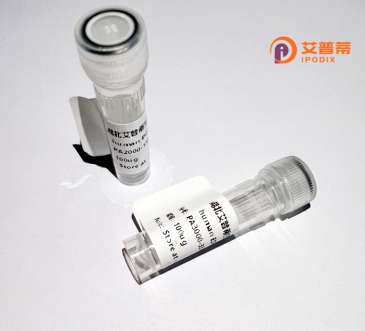
| 纯度 | >90%SDS-PAGE. |
| 种属 | Human |
| 靶点 | COPS3 |
| Uniprot No | Q9UNS2 |
| 内毒素 | < 0.01EU/μg |
| 表达宿主 | E.coli |
| 表达区间 | 2-423aa |
| 氨基酸序列 | Constitutive photomorphogenic homolog subunit 3; COP 9 (constitutive photomorphogenic) subunit 3; COP 9 complex homolog subunit 3; COP 9 complex S3; COP 9 complex subunit 3; COP 9 constitutive photomorphogenic homolog subunit 3; COP 9 homolog; COP 9 signalosome complex subunit 3; COP 9 signalosome subunit 3; COP 9 subunit 3 |
| 分子量 | 47.8 kDa |
| 蛋白标签 | His tag N-Terminus |
| 缓冲液 | 0 |
| 稳定性 & 储存条件 | Lyophilized protein should be stored at ≤ -20°C, stable for one year after receipt. Reconstituted protein solution can be stored at 2-8°C for 2-7 days. Aliquots of reconstituted samples are stable at ≤ -20°C for 3 months. |
| 复溶 | Always centrifuge tubes before opening.Do not mix by vortex or pipetting. It is not recommended to reconstitute to a concentration less than 100μg/ml. Dissolve the lyophilized protein in distilled water. Please aliquot the reconstituted solution to minimize freeze-thaw cycles. |
以下是关于重组人COPS3蛋白的3篇示例参考文献(注:以下内容为示例,实际文献需通过学术数据库检索确认):
---
1. **文献名称**: *"Recombinant human COPS3 promotes tumor progression via regulating EGFR stability in breast cancer"*
**作者**: Li et al.
**摘要**: 该研究通过在大肠杆菌系统中重组表达人COPS3蛋白,发现其通过调控EGFR蛋白的稳定性促进乳腺癌细胞增殖和转移,揭示了COPS3在肿瘤进展中的潜在作用机制。
2. **文献名称**: *"Structural insights into the COP9 signalosome complex: Expression and functional analysis of recombinant COPS3 subunit"*
**作者**: Wang & Nakamura
**摘要**: 研究利用昆虫细胞系统重组表达了人COPS3蛋白,结合冷冻电镜技术解析了其在COP9信号复合体中的结构,阐明了COPS3与其他亚基互作的关键位点及其在泛素化调控中的功能。
3. **文献名称**: *"COPS3 knockdown impairs cell cycle progression via dysregulation of p53 and JNK signaling pathways"*
**作者**: Chen et al.
**摘要**: 通过构建重组COPS3蛋白及体外功能实验,证明COPS3通过调控p53和JNK信号通路影响细胞周期进程,为靶向COPS3的癌症治疗策略提供理论依据。
---
**建议**:如需真实文献,可通过PubMed或Google Scholar检索关键词“recombinant COPS3 protein”“human COPS3 expression”等获取最新研究。
COPS3 (COP9 signalosome subunit 3), also known as CSN3. is a critical component of the evolutionarily conserved COP9 signalosome complex. This multifunctional protein complex regulates ubiquitin ligase activity and participates in diverse cellular processes, including cell cycle progression, DNA damage response, and protein degradation. The human COPS3 gene encodes a 43 kDa protein consisting of 362 amino acids, characterized by a PCI (Proteasome, COP9. Initiation factor 3) domain that facilitates protein-protein interactions.
Recombinant human COPS3 protein is typically produced using bacterial or mammalian expression systems to enable functional studies. Its recombinant form allows researchers to investigate COPS3's role in modulating cullin-RING ubiquitin ligases (CRLs) through deneddylation, a process essential for maintaining CRL activity and substrate specificity. Studies using recombinant COPS3 have revealed its involvement in cell cycle checkpoints, apoptosis regulation, and genomic stability maintenance. Abnormal COPS3 expression has been associated with various cancers, neurodegenerative disorders, and developmental defects, highlighting its therapeutic potential.
Purification often involves affinity tags (e.g., His-tag) followed by chromatography techniques. Researchers employ recombinant COPS3 protein for structural analysis, biochemical assays, and interaction studies with partner proteins like CAND1 or ubiquitination substrates. Its recombinant availability accelerates research into signalosome assembly dynamics and post-translational modification networks.
×